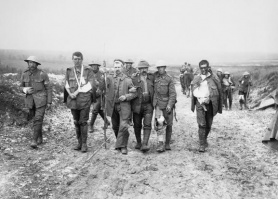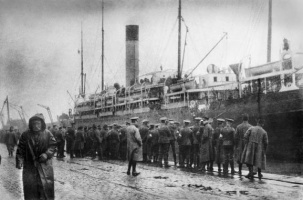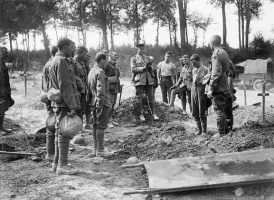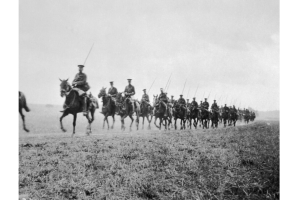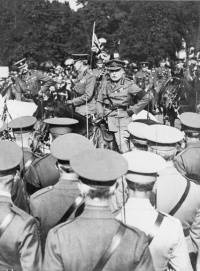Origins↑
Created in 1906 during the period of army reforms instituted by the Liberal Secretary of State for War, Richard Burdon Haldane (1856-1928), the British Expeditionary Force (BEF) originally comprised six infantry divisions and four (later five) cavalry brigades. With ancillary troops, it totalled some 150,000 highly-trained, long-service volunteers.
Role and deployment↑
Although ostensibly intended to meet a variety of strategic needs, deteriorating Anglo-German relations made it increasingly likely that, in the event of hostilities, the relatively small BEF would fight on the continent, on the left of the French army. This shift to a continental commitment was given added impetus by detailed pre-war planning influenced by the Francophile Brigadier-General Henry Wilson (1864-1922), Director of Military Operations from 1910 to 1914.
Under Field-Marshal Sir John French (1852-1925), its Commander-in-Chief, the BEF duly deployed in the Maubeuge - Le Cateau - Hirson area in August 1914, though two divisions were temporarily retained in Britain, partly owing to fears of German raids or an invasion.
Reinforcements↑
Suffering casualties of nearly 90,000 in the opening months of the conflict, the BEF lost many of its most experienced officers and men. However, in the first winter of the war it gained reinforcements from Territorial Force units, regular troops withdrawn from overseas garrisons, and divisions from India and Canada. Thus augmented, on 26 December 1914 it was reorganised into two Armies, the First and Second.
Expansion↑
A series of "New Army" formations, raised in Britain by Field-Marshal Horatio Herbert Kitchener (1850-1916), the new Secretary of State for War, also began to reach the BEF from May 1915. By the start of the Somme offensive in July 1916, the BEF – since December 1915 commanded by General (later Field-Marshal) Sir Douglas Haig (1861-1928) – had been transformed into Britain’s first-ever mass citizen army, capable at last of fighting a war on a continental scale.
The majority of the Territorial, New Army and Dominion units (which constituted the bulk of the BEF in mid-1916) had strong links with particular communities at home, giving the force a highly localised character. However, this was subsequently diluted by conscription in Britain, Canada and New Zealand and by heavy losses in the great battles of attrition of 1916-1917.
At its peak, on 1 August 1917, the BEF in France and Belgium – now, in essence, an "Army Group" of five Armies – numbered 2,044,627 officers and soldiers.
Reorganisation and Victory↑
A manpower crisis in early 1918 necessitated a reduction in the number of infantry battalions in a division from twelve to nine. Further severe losses were suffered during the German spring offensives that year. Nevertheless, in August 1918 the BEF could still field sixty infantry divisions – including ten from Australia, Canada and New Zealand – and three cavalry divisions, representing a ten-fold expansion in four years.
Moreover, since mid-1916 the BEF had undergone a notable, if sometimes uneven, organisational, technological and tactical learning process, enabling it to play a key role between August and November 1918 in the final and victorious Allied offensive.
Casualties↑
Overall, the BEF and its Dominion contingents incurred 2,690,054 battle casualties on the Western Front, including 677,515 dead or missing.
Peter Simkins, University of Birmingham
Section Editor: Catriona Pennell
Selected Bibliography
- Beckett, I. F. W. / Simpson, Keith (eds.): A nation in arms. A social study of the British Army in the First World War, Manchester; Dover 1985: Manchester University Press.
- Edmonds, James: Military operations. France and Belgium, 1914-1918, 14 volumes, London 1922: Macmillan.
- Messenger, Charles: Call to arms. The British Army 1914-18, London 2005: Weidenfeld & Nicolson.
- Sheffield, Gary: The chief. Douglas Haig and the British army, London 2011: Aurum.
- Simkins, Peter: Kitchener's army. The raising of the new armies, 1914-1916, Manchester; New York 1988: Manchester University Press.





